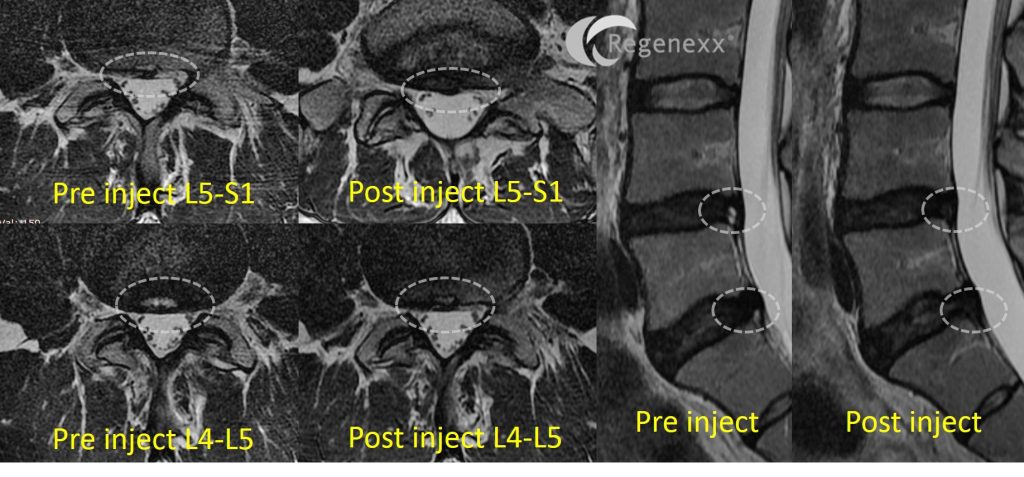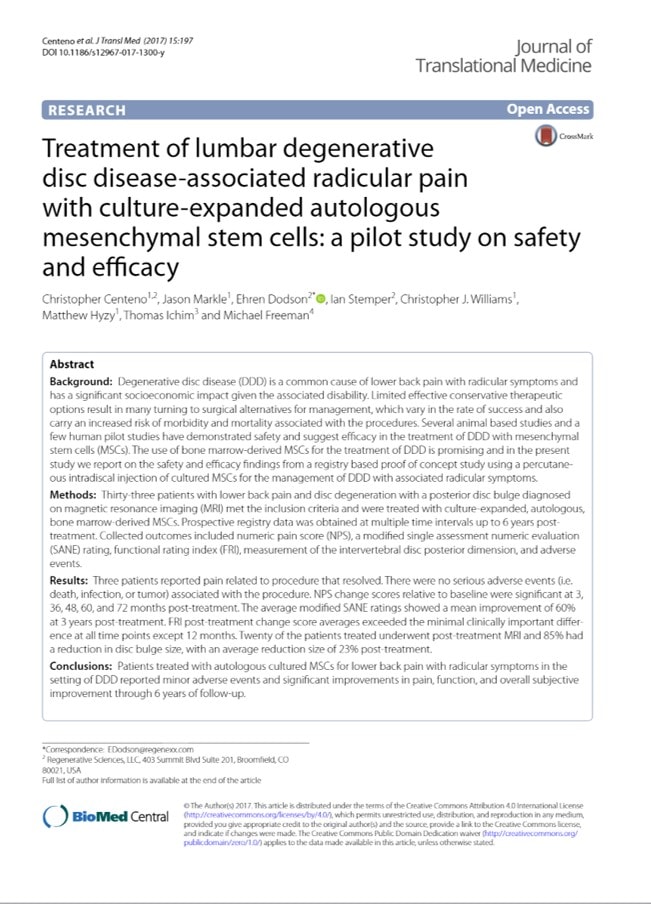Can You Get Rid of a Cervical Disc Bulge with an Injection of Bone Marrow Stem Cells?

©Regenexx
The holy grail of neck and back disc treatment is regrowing new discs by injecting something. However, so far, no clinical study to date has really confirmed that this is possible. Having said that, we’ve seen that injecting special stem cell types into low back discs can get rid of disc bulges. This morning I’d like to share with you the interesting case of a patient who got rid of a neck disc bulge through a precise injection of stem cells.
Getting Rid of Disc Bulges with Stem Cells
We were the first clinic on earth (near as I can tell) to inject stem cells into the discs of patients who had low back disc problems. At first, this treatment was a spectacular failure, mostly because I believed that it should work in people like it did in animals. For example, in rabbits, you can regrow an entirely new disc by injecting stem cells. However, once we rejiggered the therapy and set our expectations to getting rid of disc bulges that otherwise needed surgery, we began to see results. This eventually led to two papers that we published. Click on the image below to be taken to a copy of that research:
To get these results, we needed to use specially cultured cells selected to be able to survive the disc. This therapy was approved by the FDA for a phase-2 clinical trial, but it will be some time before it sees the clinic here in the U.S. We do offer it in the licensed Grand Cayman advanced culture-expansion site.
To see what this type of disc bulge treatment using sophisticated X-ray guidance looks like, watch my video that shows Dr. Pitts performing a procedure:
The Cervical Disc
The discs in the neck are a bit different from those in the low back. The discs in the low back are like a jelly doughnut. They have an outside fibrous covering and a water-containing gel on the inside. The discs in the neck are a bit more fibrous and have a bit less of the gel. Hence, since we know that things like bone marrow concentrate (BMC or a same-day stem cell procedure) can heal fibrous tissue, theoretically, in some patients, injecting BMC into the cervical disc may be able to heal the tears in the fibrous outer covering of the disc and reduce the size of a disc bulge.
Bone Marrow Concentrate and Healing Tears in the Annulus
We have noted, when a follow-up MRI is taken after the procedure, that BMC injected into a tear in the outside fibrous covering of a low back disc (annulus fibrosis) can heal a disc tear. An example of that from many years ago is below:

The bright spot in the white lines is a disc tear, which is no longer there in the post-treatment MRI.
A Patient with a Big Disc Bulge in the Neck
Michael is a 36-year-old from Philly who was seen at our Colorado HQ site by Dr. Pitts. Early last year he began to get numbness in his hands, and his MRI showed a large disc bulge at C6–C7, likely responsible for that numbness. There was also a bulge at C4–C5 as well as damage to the anterior longitudinal ligament (ALL), which was allowing the vertebrae to move backward on each other in extension. Dr. Pitts used ultrasound to place a needle precisely into the ALL and then fluoroscopy to inject both the C4–C5 and C6–C7 discs.
The patient did well clinically and had a resolution of the numbness and other pinched nerve symptoms at C6–C7. The before and after MRIs are above. Note that in the before and the four-month post-injection images that the larger disc bulge/herniation has resolved at C6–C7 (dashed yellow oval on the side views to the left and yellow triangles on the top or axial views to the right). Not much changed with the C4–C5 disc, but this was also not symptomatic.
Why Did This Work?
After studying stem cell-based disc bulge treatment for a decade and a half, my best and now educated guess as to why this disc bulge resolved with only a same-day stem cell treatment is that it was more of a chronic herniation than a true fibrous disc bulge. Between the stem cell and macrophage content of the bone marrow concentrate, that was enough to clean up and then heal the herniation and then back wall of the disc.
In addition, remember the other target of this procedure was a damaged ALL. This is the ligament in the front of the spine that acts like a piece of duct tape that holds the bones together along with the disc. It’s possible that by healing this ligament damage, the disc was also given a chance to finally heal.
The upshot? Pretty cool that you can take a nonhealing herniation that’s still causing symptoms and get it to resolve. However, a word of caution: cervical disc injection is a technically demanding procedure that should only be performed by a qualified super-specialist physician, and getting a blind injection of stem cells into the muscles is not the same procedure as you see here.

NOTE: This blog post provides general information to help the reader better understand regenerative medicine, musculoskeletal health, and related subjects. All content provided in this blog, website, or any linked materials, including text, graphics, images, patient profiles, outcomes, and information, are not intended and should not be considered or used as a substitute for medical advice, diagnosis, or treatment. Please always consult with a professional and certified healthcare provider to discuss if a treatment is right for you.

